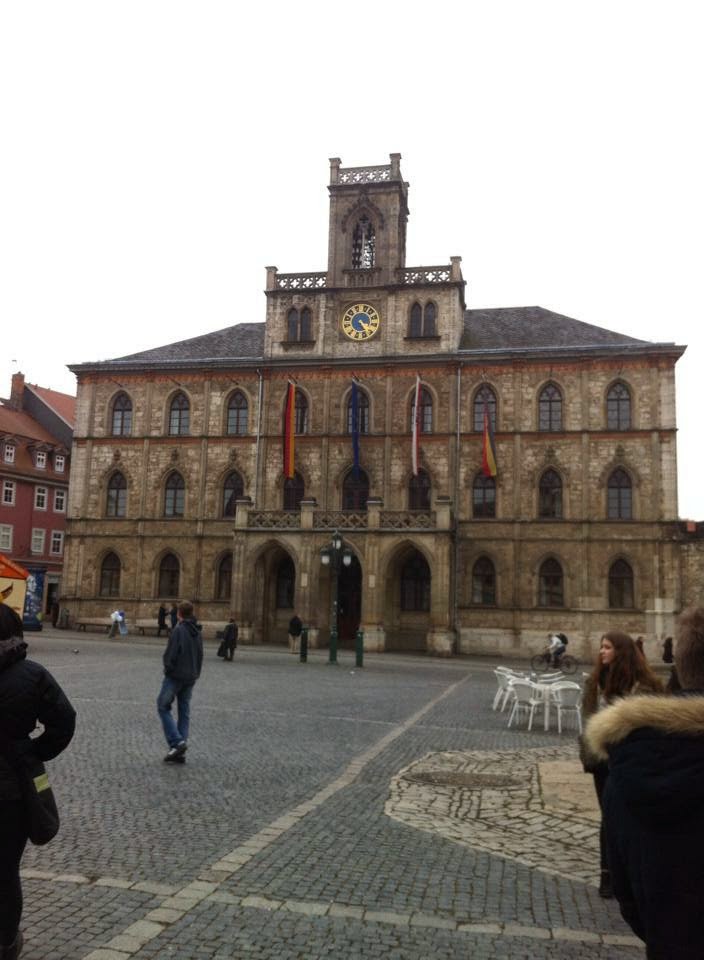The 47 Americans from my program were together again for the first time since August at our Pre-Departure Orientation in Washington D.C. To say I was looking forward to this 5-day trip would be an understatement because it has obviously been awhile since I've seen my exchange friends, especially the ones who were at language camp with me. The trip turned out better than I expected. It was also quite different than our orientations in Spain, which served more as time to reflect and do activities having to do with our year. Not exactly super fun. Here though in Weimar, we had tons of free time to hang out with our friends, we got to see the city, and we only spent three hours total sitting in groups of 15 talking to each other about our experiences so far.
The first day was weird because I had spoken face to face with another American one time since September, and now I had 46 other Americans all in one room. The thing is, Germans are not typically loud people and Americans are. If you ever need to find the group of Americans, just find where the loud noise is coming from. The other weird thing was on the first day when everyone was arriving and you would go up give them a hug, say hello or whatever and then ask --what I will call-- the three basic questions: how are things with your host family, how are things at school, and generally with friends and the language. Most people asked these questions to most other people. It was strange because I couldn't help but wonder if we were asking some people who we hadn't even spoken to in 6 months because it was polite or because we actually cared. According to the Germans the whole "asking people questions out of politeness" is a typical American thing.
Part of our Weimar Program was visiting the houses where the German writers, Schiller and Goethe, lived. Personally I liked Schiller's house better because we got an audio guide for it, so I actually feel like I learned something. Whereas in Goethe's house we didn't have an audio guide so we just walked through the house while looking around and that was it. We also went to the concentration camp that is in Weimar called Buchenwald. That makes the third one I've visited and it definitely doesn't get easier each time. The moment you walked onto the grounds there is this somber mood that makes for a silent atmosphere. At each one, I have learned something new and the exhibitions and museums are set up differently, so it really a distinct experience each time.
Part of our Weimar Program was visiting the houses where the German writers, Schiller and Goethe, lived. Personally I liked Schiller's house better because we got an audio guide for it, so I actually feel like I learned something. Whereas in Goethe's house we didn't have an audio guide so we just walked through the house while looking around and that was it. We also went to the concentration camp that is in Weimar called Buchenwald. That makes the third one I've visited and it definitely doesn't get easier each time. The moment you walked onto the grounds there is this somber mood that makes for a silent atmosphere. At each one, I have learned something new and the exhibitions and museums are set up differently, so it really a distinct experience each time.
Obviously the free time was great, it was like we were given a free trip to explore a new city with our friends. We found this place where people could play pool and air hockey, and quite a few games of Cards Against Humanity were played. There is something very enjoyable about simply sitting down and hanging out with people who haven't seen in a while, and also becoming better friends with more people.
At the end I got sick, so I didn't go to school today. Lucky for you readers, that means I was able to make this post today.
Enjoy the photos below!
 |
| Schiller's house |
 |
| The Schiller and Goethe statue |
 |
| The square in front of the town hall |
 |
| Weimar Town Hall |
 |
| The building with the tower is where watch was kept, it also serves as the entrance. The wing on the right is where the torturing cells were. |
 |
This steel plate is kept at 37 degrees Celsius, which is the human body temperature. It symbolizes life in a place where thousands and thousands of people died. |







.JPG)
.JPG)



